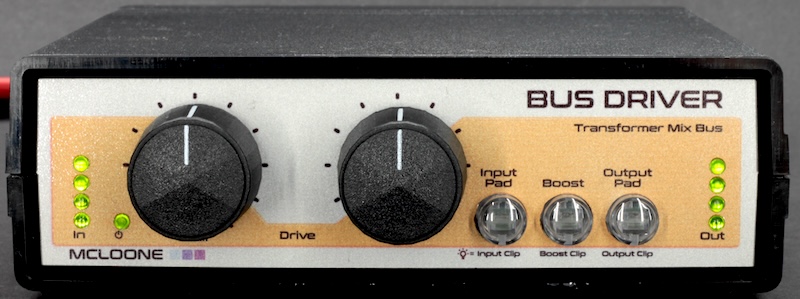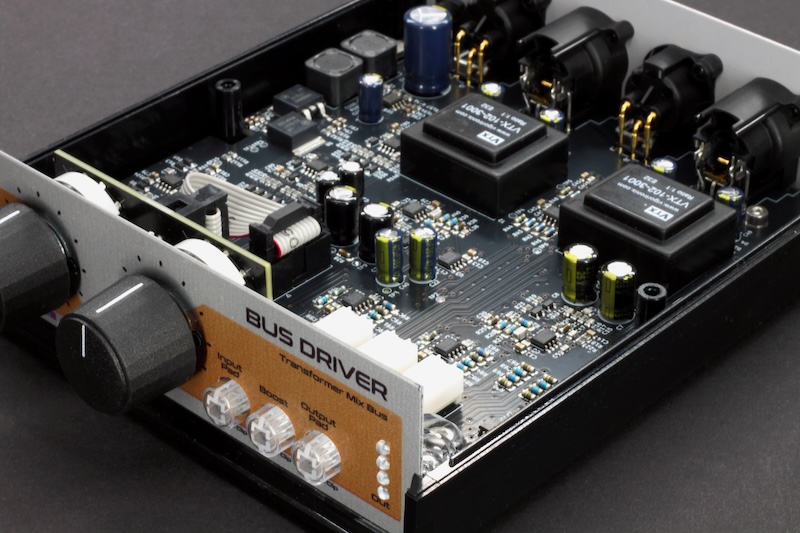

| Back To The Directory |
McLoone Bus Driver
By Barry Rudolph
 | |
| McLoone Bus Driver Front | |
 | |
| McLoone Bus Driver Rear Panel |
Mike McLoone's Bus Driver is a universal, two-channel analog, line amplifier. Having up to 40dB of gain makes it a versatile, utilitarian device great to have at the ready or permanently installed in your studio as I have done. It can be used in any part of the signal chain when more gain/level is required to keep the noise floor low and more importantly, properly drive the next device in the chain using a fully adjustable line level output.
Made in Germany and originally designed to be used to amplify the stereo output of McLoone's Mini-Bus Passive Summing mixer, Bus Driver has two, Class-A amplifiers with balanced XLR inputs and outputs. It features two UK-made Vigortronix VTX-102-3001 output transformers. These two 1:1, 600-ohm transformers are mounted directly on the circuit board and have nickel alloy cores and operate down to 20-Hz ensuring full fidelity. The transformers provide 600-ohm, balance stereo outputs and up to +22dBu with complete galvanic isolation.
The front panel has a switchable, 30dB Input pad for both channels, which allows input levels of up to +22dBu. The Input pad extends Bus Driver's operational range by accepting input signals of up to +19dBu to +22dBu. The Input and Output average levels are indicated by 4-segment LED meters on the left and right sides of the front panel.
Two more switches complete the simple front panel layout. The Boost button switches in an additional 19dB of gain for purposely overdriving the output stages and transformers. The Output Pad reduces the output level by 18db to bring the maximum output level from +22dB down to +4dB. Each of these three buttons have peak clip LEDs built-in. These act as an immediate warnings showing which of these sections are clipping and running out of operating headroom and distorting.
Controls
Bus Driver is about half a 1U rack space wide and comes as a standalone unit and is powered by an external 24-volt DC power supply (wall-wart). It also includes with the appropriate AC Power connector for your country or region. It is a small box that can sit on your desktop for immediate control of your summing mixer output or permanently installed inside in your recording studio, or stereo music system.
The two large, easy to spot the "Drive Rotary Encoders"--actually eleven-position rotary switches for setting the output level in 4dB steps. For finer resolution, I have suggested concentric trim pots be added for fine-tuning output levels--but this works fine for me too.
The rear panel has a pair of Neutrik Combi XLR input jacks and Output XLRs for input/output signals--the input connectors will accept either 1/4-inch TRS or XLR plugs. At this time, the manufacturer does not support RCA jacks (it has none anyway) but with so much gain available, Bus Driver could easily amplify -10-dBv signals from consumer equipment--receivers, Hi-Fi gear to interface with pro audio systems. Called a "bump box", you could plug in a RCA to TS (tip-sleeve) adapter cable into the input XLR Combi jack. The manufacturer has already tested this and it works.
 | |
| McLoone Bus Driver Inside |
Opening up Bus Driver's case was a big surprise with better-than-expected construction and quality component choices. The 4-layer circuit board minimizes external electrical noise and interference coming into the high-gain input section and meets with the EU's electromagnetic compliance testing.
Because of this compliance, an Italian-made, Teko plastic case can be used instead of a more expensive and heavier metal shielded box. The circuit board combines Surface-Mount Technology (SMT) and thru-the-board, hand-soldered components including the Lorin Electronics rotary switches and the E-Switch push buttons.
In My Studio
My very first use was mundane, but it is the perfect application for the Bus Drivers' super clean amplification without adding distortion, noise or coloration. I used it for driving the stereo inputs of my Hafler P300 MOS-FET Transnova power amp. I use this amp to drive numerous pairs headphones in my studio. The Hafler feeds several Simon Systems CB-4 headphone boxes that can handle up to four sets of stereo phones each. The problem was for certain singers working in my studio, I could not get their headphones loud enough. Some of the songs' dynamic, quieter sections were too soft for them to sing in pitch. I'm playing raw multi--track sessions not loud mixed and mastered recordings.
The Bus Driver gave me the ability to raise the overall volume to as loud as they could take. Since I was sending out +4dB line level audio from my monitor controller, I used the Input pad to prevent distortion and the Output pad is off. The Front panel controls were at 8 o'clock and could go louder yet if required. The Hafler did not overload or clip and my headphone system never sounded better. Big fat, clear sound was easily achieved for all of my headphones in my collection. Certain headphones require much more drive to get loud enough.
Another use I found was using it as a "bump box" to amplify the headphone jack output of my M2 Mac so it came up as +4dB source on my Pro monitor controller at about the same volume as other line level sources. In this way, I'm able to play YouTube, Zoom audio or Spotify on my main monitors. I could switch between them and other sources in my studio including the DAC output of my Pro Tools HDX rig with only small changes in volume.
All There!
The unit's compact size and flexible connection requirements make it super useful every day and I can highly recommend the McLoone Bus Driver. It comes with a 2-year warranty and sells for $449.95 plus shipping and applicable tax.
Check: Mcloone Audio
phone is: +49 30 9 91527437phone is: +49 30 9 91527437
|
|
|